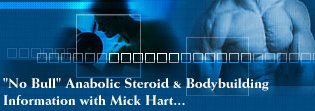
Training
techniques: the importance of training the largest muscle
groups
In order to create a highly anabolic environment within
the body, it is important that the largest muscles of the body
(primarily those that are involved in the squat, deadlift, and even
leg-pressing to a large extent, i.e. the muscles of the thigh, hip
and lower back) are trained and stimulated to grow. Why? Since these
muscles comprise such a large amount of the total muscle mass on the
human body, any training stress of sufficient intensity to cause
these muscles to grow will also place great stress on the body
overall.

These muscles
are an integral part of the physiology and mechanisms of your entire
body, i.e. they do not work on their own, and the ENTIRE body is
placed under stress and the need for growth and recuperation is
generated; for example, you need the digestion in your stomach to
supply your muscles with nutrients, and their will be a greater
demand for nutrients from very large growing muscles, and so your
stomach, for example, could well adapt and become more efficient at
digesting food, i.e. the entire body adapts including the muscles.
The effects of training ARE that far-reaching.
The stress thus
placed on your body is obviously greatest from expending enough time
and intensity training the largest muscles of your body. This
creates a highly anabolic environment in the entire body, due to the
need created in the body for extensive growth and repair of muscle
tissue, which will translate into greater gains from the training of
your smaller muscle groups, since the body works as a whole, and not
in separate, isolated parts.
The Importance of Protein and
Water
In order for your body to adapt to training stress, it
is vital that you are ingesting enough protein and carbohydrate, and
as I mentioned in the previous article, most people find that a high
protein diet, with lower relative carbohydrate levels, is better for
them: this is something that you have to experiment with for
yourself.
Also as I have mentioned before, water is a vital
component in the diet, and you can't really get enough of it when in
heavy training and consuming plenty of protein. Not only does it
serve the most important purpose of being the most abundant
constituent of muscle (muscle cells are 70% water, with the rest
being mostly protein), but large amounts of water also helps to
flush waste products from your system, and helps avoid stress on the
kidneys in this way. Also, water can be used to help flush nutrients
(e.g. amino acids, vitamins etc.) through your body, which enables
these nutrients to bathe all your tissues optimally and ensure their
optimum health, which is vital for good gains: this could not be
achieved in a low water intake environment. It's also important to
note that the amino acid L-glutamine is the most abundant amino acid
in muscle tissue, and so it's well worthwhile to supplement your
diet with extra L-glutamine.
The importance of a good
multi-vitamin and mineral supplement cannot be overlooked either, as
the growth processes cannot proceed unless all factors necessary for
growth are present, and these include vitamins and
minerals, in
addition to the necessary amino acids supplied from dietary protein,
and other dietary constituents.
With and Without
Steroids?
As I have written before in previous articles, as
much as possible should be gained from natural training before
steroids are used, and this can mean as many as 8 or 10 years of
natural training (i.e. without anabolic drugs).
When steroids are
used and the body is already very fit from years of training in the
gym, then the steroids have a much greater and more beneficial
effect than they would have on a previously untrained body, and this
is due to the difference in initial fitness between the two: the
fitter and stronger the body is to begin with, then the better it
can use the steroids and other anabolic drugs that may be
used.
|


